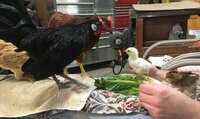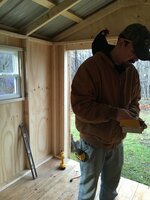AnneLovesChickens
Songster
Okay, so I have 4 chickens and 4 ducks in one pen. 2 of the chickens are cockerels. They are "teenagers" and all approximately 3 months old, give or take a couple days. They started out in separate pens, but the one cockerel (rosecomb bantam), kept hopping the fence as a baby and snuggling the ducks. He wanted to be with the ducks at all times or he'd get upset. He started crowing at 2 weeks old. He is the leader of all ducks and chickens in his mind. So a few times in these past couple of days, for no known reason, he's grabbed a female duck by the feathers on the neck and pulled down- completely upsetting the ducks but not drawing blood. What the heck? He loves the ducks, so it doesn't make sense that he'd try to attack them... is he trying to mate with them? I didn't get too upset before because it's actually kinda funny seeing this tiny chicken trying to ride a nearly full size duck. Then, this morning my rhode island red cockerel jumped ontop my Japanese bantam. I'm no expert in chicken mating but it really looked like he was trying to mate. The bantam didn't mind either. Plus, that's the first time I heard him crow. He's the passive cockerel. I started reading up and saw that one cockerel getting horny so young can make another cockerel get horny at a young age too. Are they mating? At 3 months? Should I be worried? Has anyone had this happen to them?







 Their new home will be done by january. We don't have any human children, so the birds get extra spoiled because they are our children lol. Here is a picture of my boyfriend building the coop last weekend. Rosecomb bantam (aka Daffy Duck) likes to fly on our shoulders and is supervising the construction:
Their new home will be done by january. We don't have any human children, so the birds get extra spoiled because they are our children lol. Here is a picture of my boyfriend building the coop last weekend. Rosecomb bantam (aka Daffy Duck) likes to fly on our shoulders and is supervising the construction: